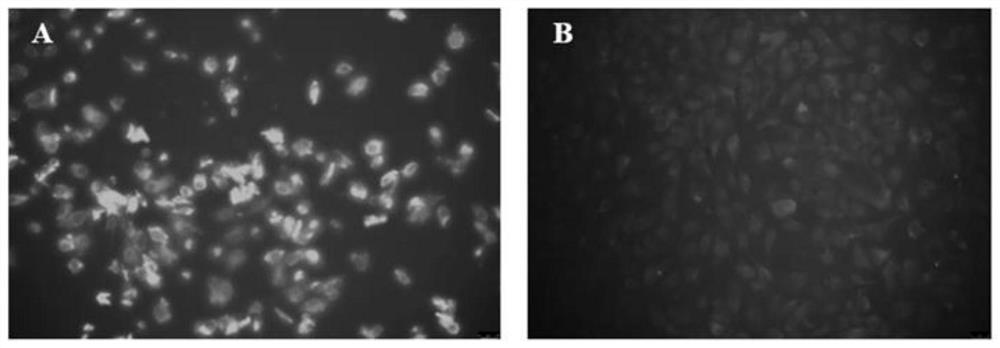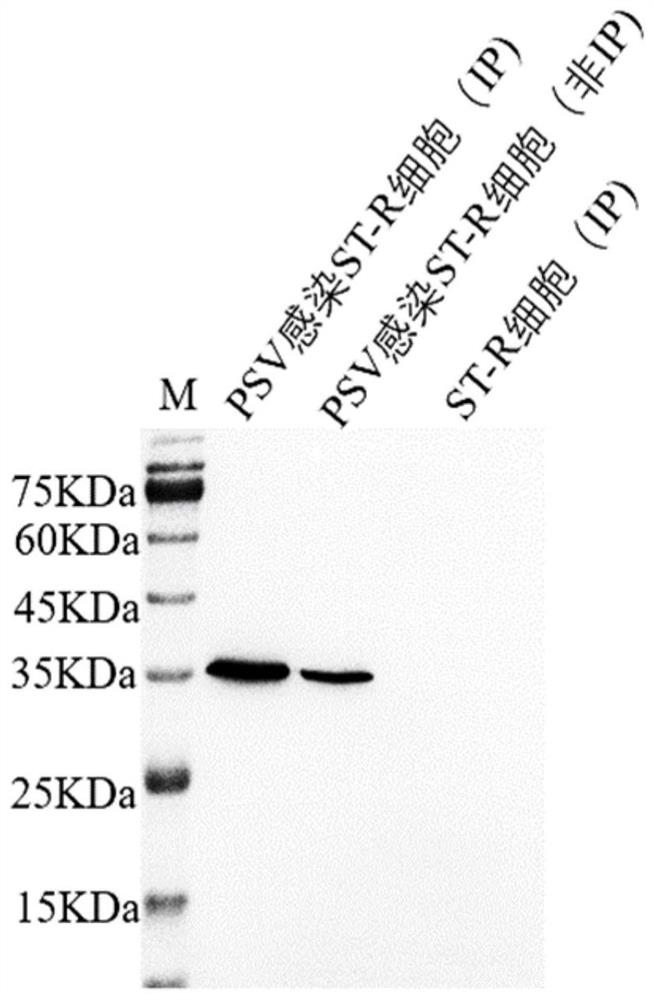Anti-porcine sapelovirus VP1 protein hybridoma cell strain, monoclonal antibody and application thereof
A hybridoma cell line, monoclonal antibody technology, applied in antiviral immunoglobulin, application, instrument and other directions, can solve the problem of no detection antibody yet
- Summary
- Abstract
- Description
- Claims
- Application Information
AI Technical Summary
Problems solved by technology
Method used
Image
Examples
Embodiment 1
[0034] The establishment of embodiment 1 monoclonal antibody hybridoma cell line
[0035] 1 Materials and methods
[0036] 1.1 Experimental materials
[0037] 1.1.1 Main reagents
[0038] HAT and HT selection medium were purchased from Beijing Boaolong Company, HRP goat anti Mouse IgG was purchased from Abcam Life Science Co., Ltd., Freund's complete adjuvant, Freund's incomplete adjuvant, PEG1450 was purchased from Sigma Company, DMEM medium was purchased from Fetal bovine serum was purchased from Gibco Company, Hangzhou Sijiqing Company, goat anti-mouse IgG fluorescent antibody was purchased from Abbkine, Protein A / G immunoprecipitation magnetic beads were purchased from Bimake Company, and fluorescence microscope was purchased from German LeiCa Company.
[0039]1.1.2 Cells, experimental animals, virus strains and serum
[0040] ST-R cells (porcine testicular cells with IFN-β receptor knockout) and SP2 / 0 myeloma cells were cryopreserved in the inventor's laboratory. Fema...
Embodiment example 2
[0071] Implementation Case 2 Characterization of Monoclonal Antibodies
[0072] (1) Indirect immunofluorescence test of monoclonal antibody and PSV
[0073] Spread the ST-R cells in a 24-well plate, inoculate the PSV virus fluid at MOI=0.01, and use uninfected ST-R cells as a negative control. About 16-20 hours after infection, discard the medium, wash with PBS 3 times, add 4% paraformaldehyde to fix at room temperature for 10 minutes, discard the fixative, wash 3 times with PBS, bovine serum albumin (BSA) and Triton-X-1001: 1 Mix and block for 30 minutes, wash with PBS 3 times, add VP1 monoclonal antibody, incubate at 37°C for 1 hour, wash with PBS 3 times, then incubate with Dylight488 goat anti-mouse secondary antibody (1:2000) for 1 hour at 37°C in the dark, wash 3 times with PBS, Observe the results with an inverted fluorescence microscope.
[0074] (2) Western blot to identify the reactivity of monoclonal antibodies
[0075] Inoculate ST-R cells in a 6-well plate, and...
Embodiment example 3
[0078] Implementation Case 3 Monoclonal Antibody Epitope Identification
[0079] (1) Preliminary identification of monoclonal antibody epitopes
[0080] Using the PSV-HuN2 strain as a template, four partially overlapping VP1 protein gene fragments A, B, C, and D were amplified, and each fragment was inserted into the pEGFP-C3 vector through restriction sites, and the positive plasmids constructed were sent to Nanjing Qing Sequencing department. According to the instructions of Entranster-H4000, each recombinant plasmid was transfected into HEK293A cells, and the total protein of the cells was collected after 36 hours. Monoclonal antibody (1:1000) was used as the primary antibody, and HRP Goat Anti-Mouse IgG was used as the secondary antibody. The region of the preliminary antigen epitope is located on the B fragment, and the amino acid position is 30-75aa. As above, segment B was divided into three partially overlapping gene segments B1, B2, and B3, relevant primers were des...
PUM
| Property | Measurement | Unit |
|---|---|---|
| Upstream primer | aaaaa | aaaaa |
Abstract
Description
Claims
Application Information
 Login to View More
Login to View More - R&D
- Intellectual Property
- Life Sciences
- Materials
- Tech Scout
- Unparalleled Data Quality
- Higher Quality Content
- 60% Fewer Hallucinations
Browse by: Latest US Patents, China's latest patents, Technical Efficacy Thesaurus, Application Domain, Technology Topic, Popular Technical Reports.
© 2025 PatSnap. All rights reserved.Legal|Privacy policy|Modern Slavery Act Transparency Statement|Sitemap|About US| Contact US: help@patsnap.com



